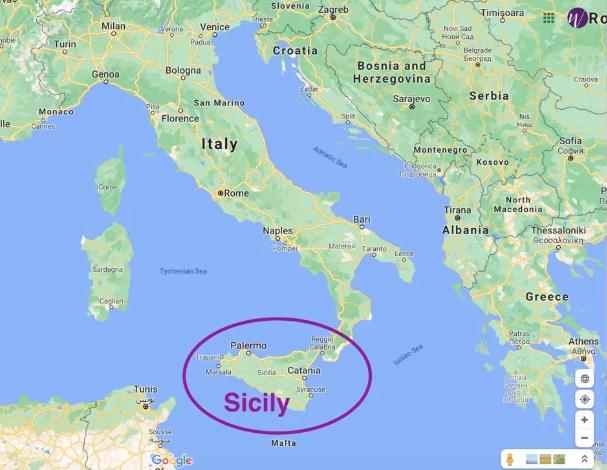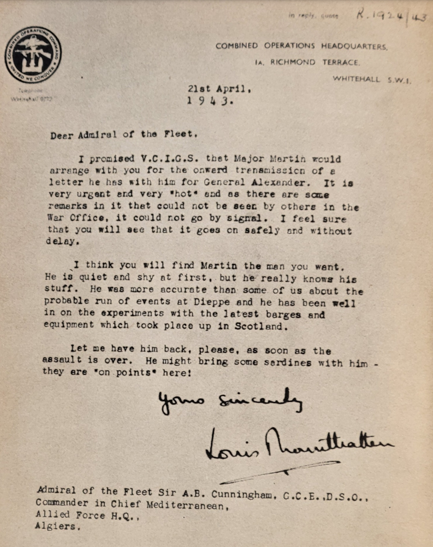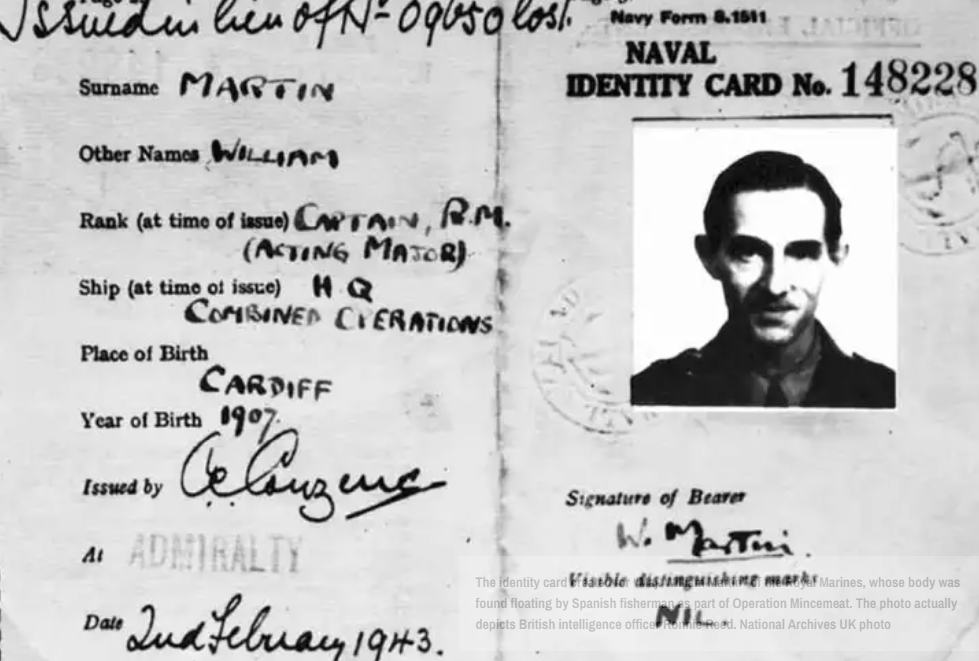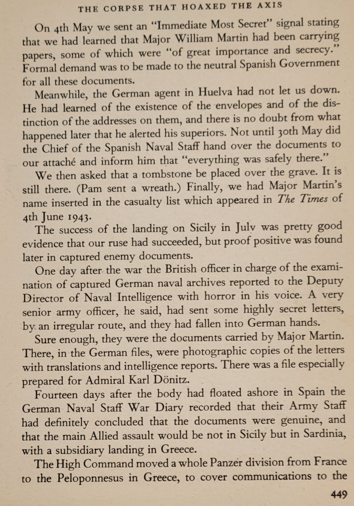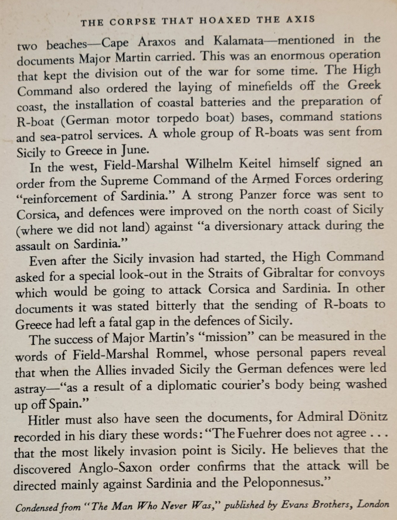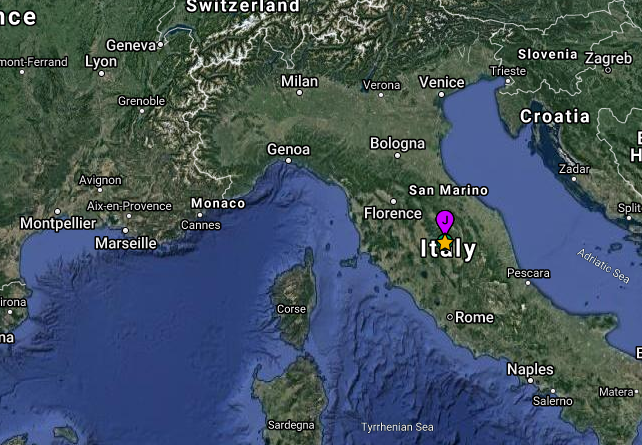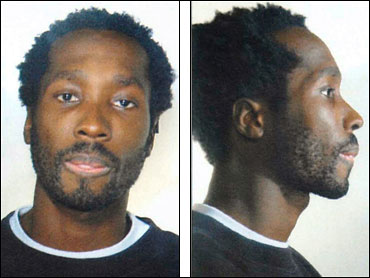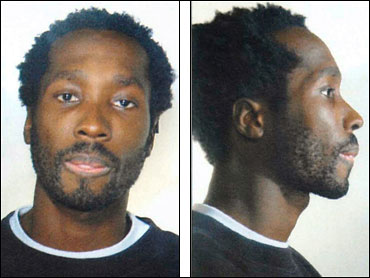 In April 1943, the body of Royal Marine Major William Martin washed up on the Spanish shore. With him were top secret documents confirming the Allies planned invasion of Italy via Greece and the Balkans rather than through Sicily which the Axis expected. This critical information caused Hitler to change strategy and redeploy forces leaving Sicily practically undefended. But it was a trick, a brilliant and resourceful scam conducted by British Naval Intelligence, and it worked. The body was not Major Martin, rather a homeless derelict—a planted British corpse that hoaxed the Nazi war machine.
In April 1943, the body of Royal Marine Major William Martin washed up on the Spanish shore. With him were top secret documents confirming the Allies planned invasion of Italy via Greece and the Balkans rather than through Sicily which the Axis expected. This critical information caused Hitler to change strategy and redeploy forces leaving Sicily practically undefended. But it was a trick, a brilliant and resourceful scam conducted by British Naval Intelligence, and it worked. The body was not Major Martin, rather a homeless derelict—a planted British corpse that hoaxed the Nazi war machine.
This elaborate ruse was perhaps the most ingenious fraud ever perpetrated in a global conflict. It was a shrewd and crafty gambit that took incredible preparation and was flawlessly executed. With Sicily wide open as the soft underbelly of Europe, the Allied forces took the land much sooner and with far fewer casualties than earlier anticipated, thanks to a sacrificed body. As a British intelligence officer who helped mastermind Operation Mincemeat said about the repurposed cadaver, “The man was a bit of a ne’er-do-well. The only worthwhile thing he ever did came after his death. He was possibly the most unlikely hero of the entire Second World War.”
We’ll get into who this dead drifter really was and how he came to con the Nazis as well as how the British organized the deceit. First, though, let’s look at history and what was going on in the Mediterranean in the spring of 1943 that required such an elaborate fake.
By January 1943 the Allies had nearly secured victory against the Axis in North Africa. British and American planners set their sights on an Italian invasion to take down Mussolini and drive their way up Italy and into the heart of Europe with the end goal of destroying the German forces. The obvious route was from North Africa and through Sicily. The Axis planners knew this too and were well prepared to stop it.
“Everyone but a bloody fool would know that it’s Sicily,” British Prime Minister Winston Churchill said at the time. “We must find a way to divert this obvious strategy. We need Hitler to believe it’s going to be Greece and the Balkans.”
That task fell to the British Office of Naval Intelligence and was code-named Operation Barclay. The disinformation campaign was overseen by Admiral John Godfrey and assisted by Lieutenant Commander Ian Fleming who would later go on to be the famous spy novelist, creating James Bond. It was Fleming who came up with the idea of planting a dead body carrying highly classified but completely false documentation that would find its way straight to the Nazi top.
The fake body sub-project of Barclay was named Operation Mincemeat. It was approved by Prime Minister Churchill and Allied Supreme Commander General Dwight D. Eisenhower. However, it was a calculated risk for if the Axis detected a ploy, it might have cemented a conviction that Sicily was the true target and the eventual invasion could be a disaster for the Allies.
Godfrey and Fleming assigned the job to intelligence officers Ewen Montagu and Charles Cholmondeley (pronounced Chumley). Montagu and Cholmondeley started their body search on February 4, 1943, by contacting the London coroner service. There were some strict parameters to have the cadaver fit the role of a highly trusted messenger—male, Caucasian, mid-thirties to early forties, in reasonable physical shape, recently deceased with limited decomposition, not autopsied, and with a cause of death being consistent with exposure to water and drowning. Also, that the dead man had no close relatives or anyone who would claim the body as this operation had to be kept vitally secure.
They quickly found their man. Welshman Glyndwr Michael, age 32, died on January 24, 1943, and was stored in the London morgue. Michael was a homeless man with no relatives to claim him. He’d been found unconscious in a vacant warehouse, presumably after eating bread scraps laced with rat poison, and died in hospital from pneumonia complications. As the cause of death was clear, the coroner did not autopsy Glyndwr Michael and had him cold stored awaiting a legal disposal.
Glyndwr Michael was the perfect fit. His remains were still in good shape, and the effect of pneumonia and fluid on the lungs would be consistent with appearing to be drowning after an airplane crash over the Atlantic waters off western Spain. The coroner, whose delightful name was Bentley Purchase, released Michael to Cholmondeley and Montagu who moved the cadaver to a truck loaded with dry ice.
Now it was time to build a detailed and credible backstory, knowing full well that German intelligence would have a microscopic look to see if Major Willam Martin was real or not.
William Martin was a common and unassuming name. He was given the rank of Captain, Acting Major in the Royal Marines and outfitted with the appropriate uniform and insignias. His military identification was carefully forged with a dead-ringer, look-alike photo and his “pocket fodder” was meticulously built. Major Martin’s effects included:
- Two dated ticket stubs to a London concert.
- A receipt for the purchase of a diamond engagement ring.
- A bank demand for repayment of an overdraft note.
- A photo of his finance “Pam”.
- A love letter from Pam.
- A contentious letter from his father citing family troubles.
- Stamps, coins, and bills.
- A metal identity band.
- Saint Christoper’s medal.
- Wristwatch and keys.
These items were corroborative to the normal life of a person like Major Martin. While they were convincing of his identity, the prize and purpose of this ruse sat inside a black attaché case chained to his belt holding an explicit document—an official dispatch from Lieutenant General Sir Archibald Nye, vice chair of the Imperial General Staff, to General Sir Harold Alexander, commander of the 18th Army Group stationed in North Africa. Part of the letter read:
We have recent information that the Bosche have been reinforcing and strengthening their defences in Greece and Crete and C.I.G.S. felt that our forces for the assault were insufficient. It was agreed by the Chiefs of Staff that the 5th Division should be reinforced by one Brigade Group for the assault on the beach south of CAPE ARAXOS and that a similar reinforcement should be made for the 56th Division at KALAMATA.
To add further credibility, the attaché case contained an introductory letter for Major Martin addressed to Admiral of the Fleet Sir A.B. Cunningham who was in Algiers. It was personally signed by Lord Louis Mountbatten.
It was now trap setting time. Major Martin’s dressed and outfitted corpse was loaded into the British submarine HMS Seraph. At night, on April 30, 1943, the Seraph surfaced 1/4 mile off the coast of Huelva, Spain. The body, fitted in a military flotation device, was set into the sea. Given a pull by an incoming tide and a push by the submarine’s propellers, the floating corpse washed up on the Spanish shore where it was found around 9:30 am by two Spanish fishermen.
This was an intentional and calculated offloading site. Allied intelligence was fully aware of an active spy well connected to the Nazis living in Huelva. They also knew the operations of the Huelva authorities who recovered the body. As per their death investigation protocol, Major Martin’s body was autopsied. A later obtained report concluded the death was drowning after exposure to sea water with his identity confirmed by the effects he was carrying. The Martin remains were released to the local British consulate, and he was formally buried in a Huelva cemetery where he still lies today.
So, what became of the secret messages? This is where the story gets interesting. After Major Martin was reported missing and presumed dead, the British authorities began a “frantic” search for him and with an “obsessed” interest in recovering the sensitive material. Their communication with the Spainards was intercepted by Nazi intelligence who now knew what was in those documents.
History proves the Nazis obtained copies of all material that was in the case connected to Martin’s belt. The sealed envelope was steamed open and resealed after immersion in salt water. Promptly, all of Martin’s effects, including the “never opened” case, were given to the consulate and returned to England.
Cleverly, the Operation Mincemeat team knew the Nazis had swallowed the bait. They’d placed an eyelash inside the sealed envelope when it left with Major Martin. Now the eyelash was gone.
History also proves the Martin documents reached German High Command in Belin and to the Fuhrer himself. After the war, a British officer in charge of examining the captured German naval archives uncovered a file especially prepared for Admiral Karl Donitz and Field Marshall Wilhelm Keitel prior to a meeting with Hitler dated 14 May 1943, fourteen days after Martin’s body was discovered. In it were copies of all the Martin documents and a notation from Donitz that “The Fuhrer does not agree that the most likely invasion point is Sicily. He believes that the discovered Anglo-Saxon order confirms that the attack will be directed mainly against Sardinia and the Peloponnesus.”
The Allied invasion on Sicily began on July 10, 1943. It met with light resistance due to Hitler being convinced that “the authenticity of the captured documents is beyond dispute”. He moved most Sicilian defense forces across to the Balkans, and the rest is history. A planted British corpse truly hoaxed the Nazi war machine.
Exerpt from the book The Man Who Never Was written by Ewen Montagu:

